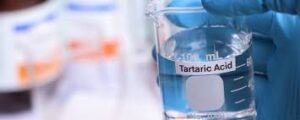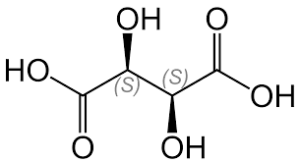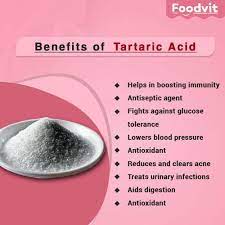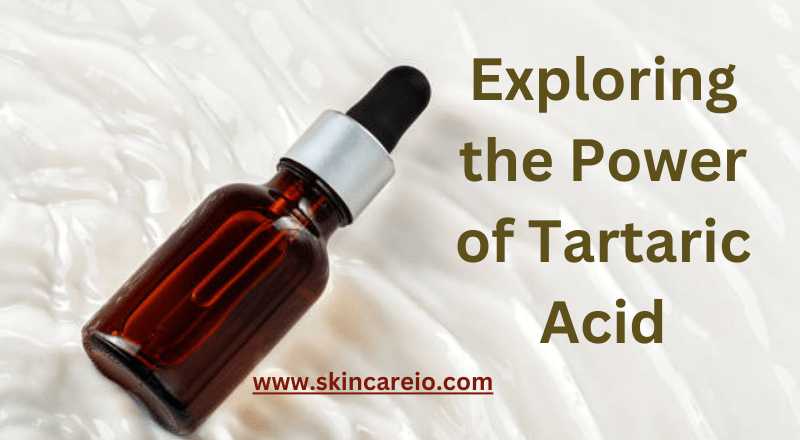Tartaric acid is a naturally occurring organic acid found in various plants, particularly grapes. It is often used in the food and beverage industry as an acidulant, but it is not a common ingredient in skincare products.
However, tartaric acid may have some potential benefits for the skin when used in specific formulations and treatments.

Benefits of Tartaric acid to Skin:
Tartaric acid, like other alpha hydroxy acids (AHAs), has exfoliating properties.
It can help remove dead skin cells from the surface of the skin, leading to smoother and brighter skin.
Exfoliation can also improve the absorption of other skincare products.
Tartaric acid can help unclog pores, making it potentially beneficial for individuals with acne-prone skin.
By removing excess oil, debris, and dead skin cells, it can reduce the risk of breakouts. Regular use of tartaric acid may contribute to an improved skin texture, making it useful for addressing rough or uneven skin.
Like other AHAs, tartaric acid can help fade hyperpigmentation, including dark spots, sunspots, and post-inflammatory hyperpigmentation (PIH).

AHAs, including tartaric acid, can stimulate collagen production, which can help reduce the appearance of fine lines and wrinkles, resulting in a more youthful complexion.
Read Also: Salicylic Solutions for Radiance
Tartaric acid can contribute to skin brightening by promoting cell turnover and reducing the appearance of dull, tired-looking skin.
It’s important to note that tartaric acid is not as commonly used in skincare products as other AHAs like glycolic acid or lactic acid. When considering skincare products containing tartaric acid, it’s essential to pay attention to the formulation and concentration to ensure its effectiveness and safety for your skin type.
Additionally, as with all exfoliating ingredients, it’s crucial to use sunscreen daily when using tartaric acid products, as they can increase skin sensitivity to the sun.
If you have specific skin concerns or are considering adding tartaric acid to your skincare routine, it’s advisable to consult with a dermatologist or skincare professional for personalized recommendations.
Various forms of Tartaric acid for skin:
Tartaric acid is not commonly used in skincare products as an active ingredient. While it belongs to the group of alpha hydroxy acids (AHAs), it is not as prevalent or widely recognized in the skincare industry as other AHAs like glycolic acid or lactic acid.

As a result, there are limited skincare products that specifically contain tartaric acid. However, if tartaric acid were to be used in skincare, it would likely be in the form of a tartaric acid solution or salt, as is the case with other AHAs.
These forms can be incorporated into various skincare products, including:
Tartaric Acid Solution:
A solution of tartaric acid and water can be used in toners, exfoliating serums, or chemical peels. It would serve as an exfoliating agent to help remove dead skin cells and improve skin texture.
Tartaric Acid Salt:
Tartaric acid can be combined with a base, such as sodium hydroxide, to form tartaric acid salts like sodium tartrate or potassium tartrate. These salts can be used as stabilizers or pH adjusters in skincare formulations.
Combination Products: Some skincare products may contain a combination of AHAs, including tartaric acid, along with other beneficial ingredients. These products could include exfoliating masks, serums, or creams designed to address multiple skincare concerns.
Precautions:
When using skincare products containing tartaric acid, it’s important to take certain precautions to ensure safe and effective use. Here are some precautions to keep in mind: Before applying any product containing tartaric acid to your face or a larger area of your body, perform a patch test. Apply a small amount of the product to a small, inconspicuous area of your skin (such as behind the ear or on the inner forearm) and wait for 24-48 hours to check for any adverse reactions, such as redness, itching, or irritation. If you experience any discomfort or allergic reactions, discontinue use immediately.

Tartaric acid, like other AHAs, can increase skin sensitivity to the sun. It’s crucial to use sunscreen daily when using tartaric acid-containing products. Look for a broad-spectrum sunscreen with SPF 30 or higher and apply it generously, even on cloudy days. This helps protect your skin from UV damage and prevents the risk of sunburn.
Read Also: The Surprising Benefits of Glycolic Acid
If you’re new to tartaric acid or AHAs in general, start with products that have lower concentrations and use them every other day or a few times a week to allow your skin to acclimate. Gradually increase the frequency if your skin tolerates it well. Be careful when applying tartaric acid products to avoid the delicate skin around the eyes. AHAs can be too harsh for this area and may cause irritation. After using tartaric acid products, follow up with a moisturizer to help maintain the skin’s moisture balance and reduce the risk of dryness or irritation.
Be cautious when combining tartaric acid with other active ingredients, such as retinoids or benzoyl peroxide, as this can increase the potential for irritation. It’s advisable to consult with a dermatologist or skincare professional before using multiple active ingredient s together. If you have sensitive skin, skin conditions like eczema or rosacea, or if you’re unsure about how to incorporate tartaric acid into your skincare routine, it’s best to consult with a dermatologist or skincare professional.
They can provide personalized guidance and product recommendations. Properly store tartaric acid-containing products according to the manufacturer’s instructions to maintain their efficacy and stability. Keep them away from direct sunlight and extreme temperatures.
By following these precautions and being mindful of your skin’s response, you can safely incorporate tartaric acid into your skincare routine and enjoy its potential benefits without causing harm or irritation to your skin.
